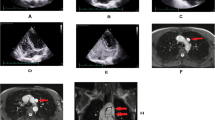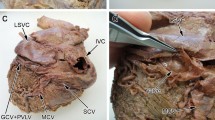Abstract
Persistent left superior vena cava (PLSVC) is one of the cardiac system abnormalities with a 0.3–0.5% incidence and caused by inadequate obliteration of the left anterior cardinal vein during embryonic development. Prognosis of PLSVC is generally assumed to be good if it is not accompanied by other cardiac system abnormalities. During the routine ultrasound control of a patient at 25th week of pregnancy at the Obstetrics and Gynecology Department of Mersin University, PLSVC anomaly was detected in an intrauterine fetus. Then, intrauterine death occurred and after removal of the deceased fetus, PLSVC diagnosis was confirmed by autopsy. According to the autopsy findings, right superior vena cava (SVC) and azygos vein were found in normal course. PLSVC opened into the right atrium via enlarged coronary sinus. There was no connection between the two SVCs. On the left side of posterior mediastinum, instead of hemiazygos or accessory hemiazygos veins, a vein symmetrical to azygos was opened into PLSVC, similar to the one on the right. No other cardiac anomaly associated with PLSVC or any other pathology in the other parts of body that could be responsible for death was discovered during autopsy. There was no evidence indicating that PLSVC played any role in intrauterine exitus of the present case. However, as mentioned in the literature, the ectopic beats in the atrium wall of patients with isolated PLSVC and enlarged coronary sinus may lead to pathologies in the conduction system of the heart. Considering the intrauterine death of an isolated PLSVC case associated with cardiac conduction pathologies, we recommend that the common assumption of ‘isolated PLSVC is not associated with death’ should be reviewed by studies on large series and even intrauterine cases should be closely monitored for cardiac arrhythmia.




Similar content being viewed by others
References
Ari ME, Doğan V, Özgür S et al (2017) Persistent left superior vena cava accompanying congenital heart disease in children: experience of a tertiary care center. Echocardiography 34:436–440
Berg C, Knüppel M, Geipel A et al (2006) Prenatal diagnosis of persistent left superior vena cava and its associated congenital anomalies. Ultrasound Obstet Gynecol 27:274–280
Biffi M, Boriani G, Frabetti L, Bronzetti G, Branzi A (2001) Left superior vena cava persistence in patients undergoing pacemaker or cardioverter-defibrillator implantation: a 10-year experience. Chest 120:139–144
Campbell M, Deuchar DC (1954) The left-sided superior vena cava. Br Heart J 16:423–439
Farazi Chongouki C, Dalianoudis I, Ninos A et al (2019) Double superior vena cava: presentation of two cases and review of the literature. Acta Chir Belg 19:1–6
Goyal SK, Punnam SR, Verma G, Ruberg FL (2008) Persistent left superior vena cava: a case report and review of literature. Cardiovasc ultrasound 6:50
Hsu LF, Jaïs P, Keane D et al (2004) Atrial fibrillation originating from persistent left superior vena cava. Circulation 109:828–832
James TN (1962) Classification of triatrial hearts. Anat Rec 143:79–91
Kellman GM, Alpern MB, Sandler MA, Craig MB (1988) Computed tomography of vena caval anomalies with embryologic correlation. Radiographics 8:533–556
Li J, Mao Q, Sun Z, Li Q (2017) A rare variant between the left superior vena cava and the azygos vein. Surg Radiol Anat 39:107–109
Limura A, Oguchi T, Shibata M, Matsuo M, Takahashi T (2011) Double superior vena cava and anomaly of cardiovascular system with a review of the literature. Okajimas Folia Anat Jpn 88:37–42
Momma K, Linde LM (1969) Abnormal rhythms associated with persistent left superior vena cava. Pediatr Res 3:210–216
Morgan DR, Hanratty CG, Dixon LJ, Trimble M, Keeffe DBO (2002) Anomalies of cardiac venous drainage associated with abnormalities of cardiac conduction system. Europace 4:281–287
Morgan LG, Gardner J, Calkins J (2015) The incidental finding of a persistent left superior vena cava: implications for primary care providers case and review. Case Rep Med 2015:198754
Nandy K, Blair CB Jr (1965) Double superior venae cavae with completely paired azygos veins. Anat Rec 151:1–9
Özsürmeli M (2019) Prenatal diagnosis of persistent left superior vena cava: a retrospective study of associated congenital anomalies. Turk J Obstet Gynecol 16:23–28
Povoski SP, Khabiri H (2011) Persistent left superior vena cava: review of the literature, clinical implications, and relevance of alterations in thoracic central venous anatomy as pertaining to the general principles of central venous access device placement and venography in cancer patients. World J Surg Oncol 9:173
Sarodia BD, Stoller JK (2000) Persistent left superior vena cava: case report and literature review. Respir Care 45:411–416
Standring S, Borley NR, Collins P, Crossman AR, Gatzoulis MA, Healy JC (2008) Gray’s anatomy: the anatomical basis of clinical practice. Elsevier, London
Steinberg I, Dubilier W Jr, Lukas DS (1953) Persistence of left superior vena cava. Dis Chest 24:479–488
Tubbs RS, Shoja MM, Loukas M (2016) Bergman’s comprehensive encyclopedia of human anatomic variation. Wiley-Blackwell, New Jersey
Weiss C, Willems S, Meinertz T, Kuck KH, Cappato R (1999) Prospective evaluation of the coronary sinus anatomy in patients undergoing electrophysiologic study. Clin Cardiol 22:537–543
Funding
This research did not receive any specific grant from funding agencies in the public, commercial, or not-for-profit sectors.
Author information
Authors and Affiliations
Contributions
ZÇ, FT, DE, OB, ZKO: project development, data collection, data analysis, manuscript writing, and manuscript editing.
Corresponding author
Ethics declarations
Conflict of interest
The authors declare no conflict of interest.
Additional information
Publisher's Note
Springer Nature remains neutral with regard to jurisdictional claims in published maps and institutional affiliations.
Rights and permissions
About this article
Cite this article
Çetin, Z., Tuncel, F., Erdoğan, D. et al. Autopsy findings of an isolated persistent left superior vena cava in an intrauterine dead fetus. Surg Radiol Anat 42, 391–395 (2020). https://doi.org/10.1007/s00276-020-02434-6
Received:
Accepted:
Published:
Issue Date:
DOI: https://doi.org/10.1007/s00276-020-02434-6




